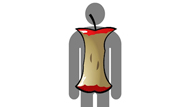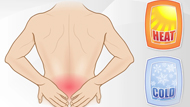History and Physical Exam for Low Back Pain
Exam Overview
A thorough history to evaluate low back pain includes an assessment of:
- Your description of how the pain started. This includes whether it was sudden or gradual.
- Pattern, intensity, and duration of the current episode of low back pain. You may be asked to complete a pain drawing to identify the sites and symptoms of pain.
- What brings on or increases your pain and what makes you feel better. This includes whether you feel better with activity or with rest.
- Related symptoms, such as leg pain, weakness, or numbness; or problems with your bowels or bladder.
- Spine problems you have had since birth (congenital spine problems).
- Any type of arthritis in your spine.
- Previous episodes of low back pain and treatment.
- Previous accidents or injuries involving the back.
- Family history of low back pain.
- Work history. This includes any link between your work and your current back pain.
- Sports and other leisure activities.
- Any legal action related to your back pain.
- History of cancer and other illnesses, such as abdominal disease, pelvic disease, or osteoporosis.
- Recent fever or unexplained weight loss.
- Corticosteroid use.
- Your smoking history.
Your doctor or nurse may also give you a written questionnaire to screen for depression or to assess how low back pain is affecting your life, to rate your job satisfaction, and to describe your support system at home and at work.
During the physical exam, your doctor will ask you to do a series of movements while you stand, sit, and lie down. This makes it possible to assess muscular and sensory problems contributing to your low back pain. The physical exam will also include:
- Observations and measurements.
- Palpation, in which your doctor will feel for tenderness and joint alignment and check pulses in your legs.
- General exam of the trunk and legs.
- Nerve tests.
- Specific tests such as a straight leg test.
The results of these tests will help your doctor see whether your back pain and other symptoms are related to pressure on a nerve and which nerve or nerves may be compressed. Your doctor will use this information to help determine what type of treatment is most likely to be effective.
Why It Is Done
The history and physical exam are the first part of the work-up for low back problems. Your doctor may change or skip some of the tests to avoid further injuring your back.
Results
The history and physical exam for low back pain may provide these results:
Normal
History does not reveal an obvious cause of the low back pain.
A physical exam does not cause the same type of pain, muscle weakness, or nerve-related symptoms that you have been having.
Your doctor may recommend:
- Nonsurgical treatment (rest, pain relievers, heat or ice, exercise).
- More tests and exams to find out whether some other medical problem is causing your low back pain.
Abnormal
The medical history and physical exam are likely to distinguish between a low back problem related to a muscle strain or overuse and one that is caused by pressure on a nerve or another more unusual problem.
- If your back pain seems to be related to muscle strain or overuse, or if your nerve-related symptoms are not severe, your doctor will likely recommend conservative treatment (rest, pain relievers, heat or ice, exercise) for a period of time to see whether your symptoms improve.
- If your nerve-related symptoms are more serious or if your doctor suspects that there is a more serious problem, he or she may recommend more tests, such as X-ray, magnetic resonance imaging (MRI), computed tomography (CT), or blood tests.
What To Think About
Pain can be related to both physical and emotional causes. When you're stressed, for example, muscle tightness or spasm can set into your back, causing pain or making it worse. Similarly, troubling emotions can make pain worse. If you or your doctor have a sense that your pain is being caused or made worse by stress, anger, or other difficult emotions, be sure to plan for specialized treatment. Cognitive-behavioral therapy and biofeedback are two types of treatment that can give you tools for managing your pain.
Complete the medical test information form (PDF) (What is a PDF document?) to help you prepare for this test.
Current as of: March 21, 2017
Author: Healthwise Staff
Medical Review: William H. Blahd, Jr., MD, FACEP - Emergency Medicine & Adam Husney, MD - Family Medicine




